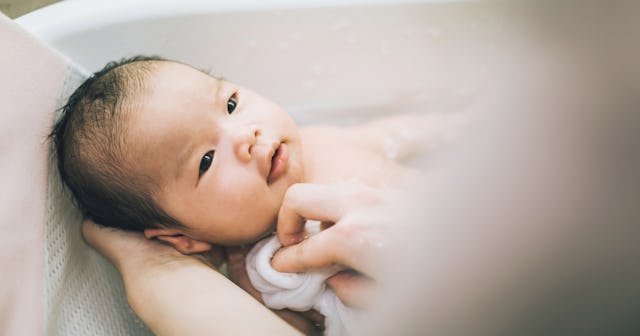Everything To Know About Safe Baby Bath Temperature

Bath time is a fun time for you to bond with your baby. They get to splash around and be unencumbered by a diaper or clothes, and it’s the perfect time for you to connect with your little one by engaging with them, talking with them, and making eye contact. It’s also a great way to establish a routine and teach your baby the difference between “busy time” and “sleep time” — while at the same time providing them with a yummy way of relaxing and winding down before bed. But bathing a newborn, especially for the first time, can be nerve-racking. Your baby might not love bathing at first, and you might need some practice with it too. Newborn babies can be a bit slippery! Then there are the logistics of the bath. How long should it be? What is the perfect baby bath temperature? You want your baby to be comfortable, of course. Not too cold, not too hot, but just right.
In other words, it’s only natural to have some motherhood anxiety before your little cutie gets clean. So, if you need some help figuring out your baby’s bath temperature and how to test it, we’ve got you. Read on to learn everything you need to know.
Looking for more baby care tips? We have pages on bow-legged babies, an “am I ready for a baby” advice page, and more.
What is the best baby bath temperature?
You want to find the perfect medium for your baby’s safety and comfort with their tub water temperature. You want the water more warm than cold since a baby gets cold easily. Aim for the bath water’s temperature to be around 100 degrees Fahrenheit, maybe a few degrees above, but definitely below 120 degrees. The room should stay at a nice and toasty temp, too. To prevent scalding, it’s recommended to set the thermostat on your home’s water heater to below 120 degrees — just in case!
You might need to hire a plumber to install a valve or thermostatic mixing valve at your water heater or hot water supply. Also, you may want to consider installing anti-scalding devices to place on taps and shower outlets to reduce the risk of scalding.
How do you check the bath temperature?
There are a couple of methods to best check your baby’s bath temperature. One of the simplest ways is to use a thermometer. There are many cute digital waterproof thermometers on the market. There are even tubs with baby thermometers built right in! However, that’s not totally necessary — you can even test the water with your wrist or elbow. First, swirl the water around to break up any hot spots (just as you would before drawing your own bubble bath). It’s also a good idea to run the cold water first and then turn on the hot water to warm up the bathwater.
If baby has a fever what should the bath temperature be?
If a baby is dealing with a fever, it’s important to cool them down properly during bath time. Stick to a lukewarm bath around 90 to 95 degrees. Do not try to bring their fever down using rubbing alcohol, ice, or cold water. This will lower the baby’s body temperature too quickly. Give them a sponge bath for about 20 minutes and if the child starts shivering, stop and wrap them up in a towel or blanket.
How much water should you fill the tub with?
Whether you’re using your bathtub, a baby bathtub, or a sink, keep the water level at a minimum to ensure your little one’s safety. A common recommendation is about two inches of water. Some research indicates that having enough water to cover your baby’s shoulders helps keep them warm and calm. You might also consider periodically (and gently) pouring water over your baby’s body to keep them warm during bath time.
No matter how much water you use, it’s important to keep a secure yet comfortable hold on your baby throughout their splish-splash time. And never leave your baby alone in the tub — not even for a split second. Babies can quickly drown in as little as one inch of water.
How long should a bath be for your baby?
Unlike yourself, who might enjoy a nice hour-long bath, your baby only requires a quick five to 10-minute bath at first. Warm water can easily irritate a baby’s skin, so you want to make bath time a short and sweet activity for them.
This article was originally published on